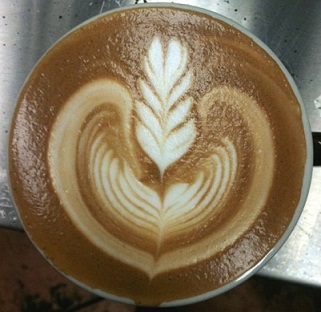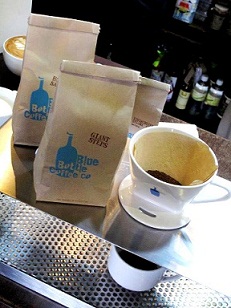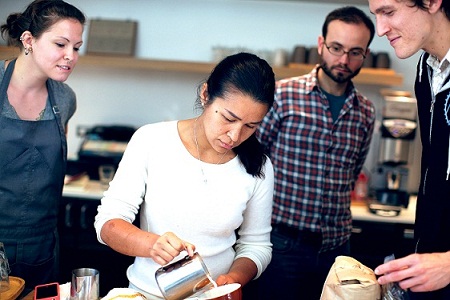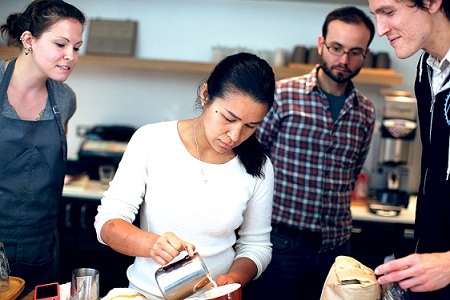NO, it’s not about the caffeine.
Question: would you wait in line for 30 minutes and pay seven dollars for a cup of coffee? Most people will not, but there are who will.
There are coffee drinkers, coffee lovers and coffee aficionados. For most people, it’s a drink. For others, it’s a treat. And for the discriminating, it’s a science and an art.
When you order a cup from master barista Selina Viguera, who’s based at the Ferry Building branch of Blue Bottle Coffee Company in San Francisco, the first question that she will ask you is: how do you want your coffee?
But hold on, it’s not that simple. This is where science and art come in. Before Viguera makes your cup, she needs a scale and a timer. And then she and her fellow Blue Bottle baristas make coffee by hand, using porcelain drips and paper filters.
And if you ask her about the nuances of the bean, her answers might make you feel like you’re having vertigo.
How coarse or how fine should you grind the beans? How dark should you roast the beans? At what temperature and for how long? How long do roasted beans stay fresh? How long do ground beans stay fresh?
How much of ground coffee per cup? At what temperature should the milk be? What do you do to neutralize the paper filter taste? How fast should you pour the water into the porcelain drip? In how many minutes should the coffee drip into the cup?
 Wait a minute. This is about making coffee, not formulating rocket fuel.
Wait a minute. This is about making coffee, not formulating rocket fuel.
It boils down to this: bringing out the best in the bean, and making coffee by hand adds a personal touch. “There are people who don’t care how the coffee is made, who don’t know the difference,” says Viguera. “But there are people who actually watch you while you’re making something, and they say ‘This is going to be good.’”
There is nothing wrong with using an espresso machine, Viguera assures, but to her it’s merely pushing buttons. Think of machines versus humans.
There is a personal connection when making cups of coffee by hand, like how a painter feels his creation is an embodiment of himself. “It makes you feel like a professional. You know what you’re doing,” she explains.
That personal touch extends to being warm to customers. “Being a barista isn’t just about making the coffee. It’s creating the experience and a relationship with the customer,” she says. A lot of her customers become her friends on Facebook.
Viguera and her staff don’t just take customers’ orders, they talk to their customers.
That’s even when everyone is hustling to get drinks out and customers are waiting in line for 30 minutes to place their orders. If Viguera spots her baristas aren’t smiling, her temper simmers aside from the coffee. They keep in mind that customers aren’t there for the conversation, of course.
“For me, the fun is in connecting with your customers, having pride in what you’re creating. It’s that interest that takes you to the next level of what you can do. Anybody can make coffee, but not everybody is a good barista.”
 Viguera won’t claim that they make the best coffee in the San Francisco bay area. Coffee drinkers’ tastes vary, she says. If that is the case, then the best coffee in the world is how you like your cup.
Viguera won’t claim that they make the best coffee in the San Francisco bay area. Coffee drinkers’ tastes vary, she says. If that is the case, then the best coffee in the world is how you like your cup.
“By the standards of the coffee industry, we are not making it according to standards,” Viguera says of Blue Bottle. “It’s about how you like your coffee and how we like to make it.”
Still, to Viguera, being a barista is not just about taking orders but being the master of her craft — to educate mortals about the bean. “You may be giving me your money, but I’m the professional,” she emphasizes.
She encourages people to try different coffees because you might find something that suits your taste. You can’t say your favorite brew is the best if you haven’t tried others that are waiting to be discovered.
One coffee that Viguera wants to see in the international scene someday is the liberica variety, known in the Philippines as barako coffee for its strength. “I don’t think you find that anywhere else,”she says.
Viguera sees herself bringing the hand-drip coffee concept to her native Philippines one day, keeping in mind that the country was once known for its coffee.
“It’s exciting for me to know that the industry here is developing, that there is interest and that there is so much room for growth,” she says.
During a recent visit to Manila, Viguera gave a two-hour demonstration on how to make hand-drip coffee to about 30 coffee aficionados at a coffee shop. It didn’t take long for the audience to crowd around and the coffee questions to pour in.
“My Pinoy pride comes in by creating an awareness that things can be made better,” Viguera says with a missionary conviction. “The big part of being a barista is educating and being able to connect with people, changing people’s thoughts on what coffee is and how it should be enjoyed.”

